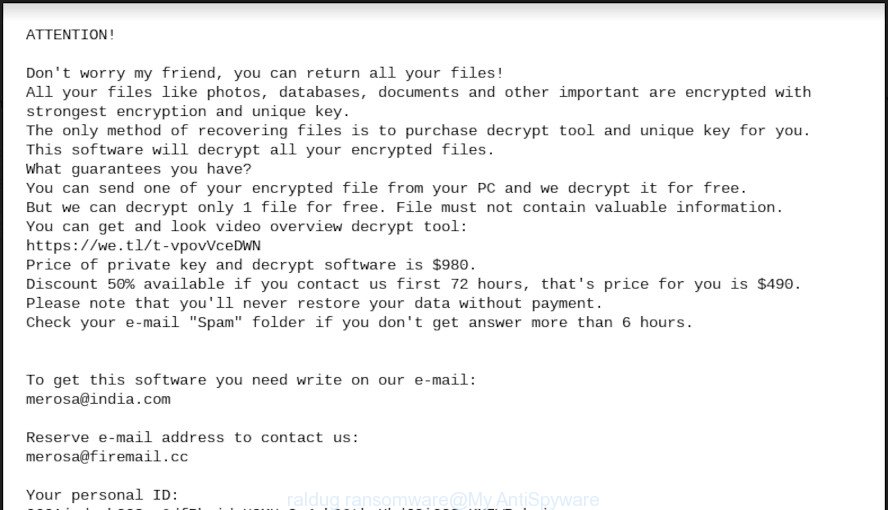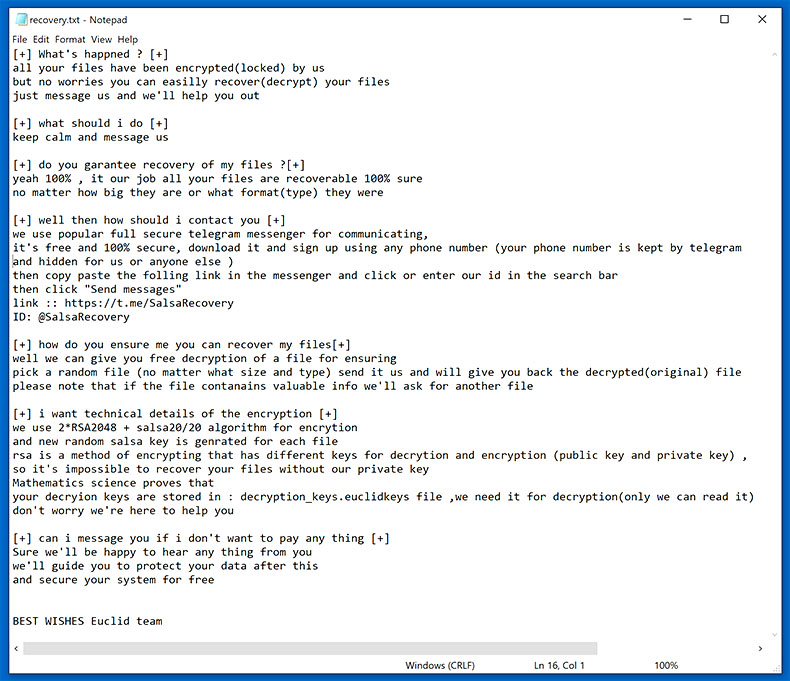What is Raldug ransomware? And how does it carry out its attack?
Raldug ransomware is a data-encrypting malware designed to lock important files in an infected computer. It is related to both Djvu ransomware and STOP ransomware. It uses a “.raldug” extension to mark the files it encrypts. This threat uses a sophisticated encryption algorithm but the good thing is that security experts were able to come up with a free decrypter which will be discussed in this post.
Once Raldug ransomware infiltrates a computer, it uses a built-in infection sequence which starts with a data gathering process used to extract data classified into two namely, user personal data and attack optimization data. The acquired data is then used for another malicious process in order to bypass security programs installed in the computer. In this process, Raldug ransomware looks for signatures of antivirus programs, virtual machine hosts and sandbox environment and once it finds programs with these signatures, their real-time engines are either shut down or removed. After that, it also alters the Windows Registry to allow it to run on every system boot. It then scans the computer for its targeted files and encrypts them with both the AES and RSA 1024 ciphers. Following data encryption, Raldug ransomware appends the .raldug extension to every affected file and releases its ransom note named “_open_.txt”, which states:
“ATTENTION!
Don’t worry my friend, you can return all your files!
All your files like photos, databases, documents and other important are encrypted
with strongest encryption and unique key.
The only method of recovering files is to purchase decrypt tool and unique key for you.
This software will decrypt all your encrypted files.
What guarantees you have?
You can send one of your encrypted file from your PC and we decrypt it for free.
But we can decrypt only 1 file for free. File must not contain valuable information.
You can get and look video overview decrypt tool:
hxxps://we.tl/t-1LFQOfI0Se
Price of private key and decrypt software is $980.
Discount 50% available if you contact us first 72 hours, that’s price for you is $490.
Please note that you’ll never restore your data without payment.
Check your e-mail “Spam” folder if you don’t get answer more than 6 hours.
To get this software you need write on our e-mail:
[email protected]
Reserve e-mail address to contact us:
[email protected]
Your personal ID:”
How does Raldug ransomware spread online?
Raldug ransomware spreads with the help of malicious spam email campaign which contains harmful attachment. This malicious attachment may be a document with macro scripts that is used to launch Raldug ransomware into the system. Thus, you need to be extra careful in opening emails no matter who sent them and always do a double check before you open any attachment as it may contain the malicious payload of ransomware threats like Raldug ransomware.
Eliminate Raldug ransomware from your infected computer with the help of the following removal guide.
Step 1: First, tap the Ctrl + Shift + Esc keys in your keyboard to open the Task Manager.
Step 2: After opening the Task Manager, go to the Processes tab and look for any suspicious-looking process that takes up most of your CPU’s resources and is most likely related to Raldug ransomware.

Step 3: After that, close the Task Manager.
Step 4: Tap Win + R, type in appwiz.cpl and click OK or tap Enter to open Programs and Features under Control Panel.
Step 5: Under the list of installed programs, look for Raldug ransomware or anything similar and then uninstall it.

Step 6: Next, close Control Panel and tap Win + E keys to launch File Explorer.
Step 7: Navigate to the following locations below and look for Raldug ransomware’s malicious components such as “_open_.txt” and [random].exe and other suspicious files, then delete all of them.
- %TEMP%
- %APPDATA%
- %WINDIR%\System32\Tasks
- %APPDATA%\Microsoft\Windows\Templates\
- %USERPROFILE%\Downloads
- %USERPROFILE%\Desktop
Step 8: Close the File Explorer.
Before you proceed to the next steps below, make sure that you are tech savvy enough to the point where you know exactly how to use and navigate your computer’s Registry. Keep in mind that any changes you make will highly impact your computer. To save you the trouble and time, you can just use [product-name], this system tool is proven to be safe and excellent enough that hackers won’t be able to hack into it. But if you can manage Windows Registry well, then by all means go on to the next steps.
Step 9: Tap Win + R to open Run and then type in regedit in the field and tap enter to pull up Windows Registry.

Step 10: Navigate to the following path:
- HKEY_CURRENT_USER\Control Panel\Desktop\
- HKEY_USERS\.DEFAULT\Control Panel\Desktop\
- HKEY_LOCAL_MACHINE\Software\Microsoft\Windows\CurrentVersion\Run
- HKEY_CURRENT_USER\Software\Microsoft\Windows\CurrentVersion\Run
- HKEY_LOCAL_MACHINE\Software\Microsoft\Windows\CurrentVersion\RunOnce
- HKEY_CURRENT_USER\Software\Microsoft\Windows\CurrentVersion\RunOnce
Step 11: Delete the registry keys and sub-keys created by Raldug ransomware.
Step 12: Close the Registry Editor and empty the Recycle Bin.
Try to recover your encrypted files using the options given below.
You can restore the files encrypted by Raldug ransomware by downloading this free decrypter. On the other hand, you can also use another alternative method to recover them using the Previous Versions feature in Windows but keep in mind that this method will only work if the ransomware threat hasn’t deleted the shadow volume copies of your files.
To restore the encrypted file using Previous Versions, right-click on it and select Properties, a new window will pop-up, then proceed to Previous Versions. It will load the file’s previous version before it was modified. After it loads, select any of the previous versions displayed on the list like the one in the illustration below. And then click the Restore button.

Complete the removal process of Raldug ransomware by using a trusted and reliable program like [product-name]. Refer to the following guidelines on how to use it.
Perform a full system scan using [product-code]. To do so, follow these steps:
- Turn on your computer. If it’s already on, you have to reboot it.
- After that, the BIOS screen will be displayed, but if Windows pops up instead, reboot your computer and try again. Once you’re on the BIOS screen, repeat pressing F8, by doing so the Advanced Option shows up.

- To navigate the Advanced Option use the arrow keys and select Safe Mode with Networking then hit
- Windows will now load the Safe Mode with Networking.
- Press and hold both R key and Windows key.

- If done correctly, the Windows Run Box will show up.
- Type in the URL address, [product-url] in the Run dialog box and then tap Enter or click OK.
- After that, it will download the program. Wait for the download to finish and then open the launcher to install the program.
- Once the installation process is completed, run [product-code] to perform a full system scan.

- After the scan is completed click the “Fix, Clean & Optimize Now” button.












